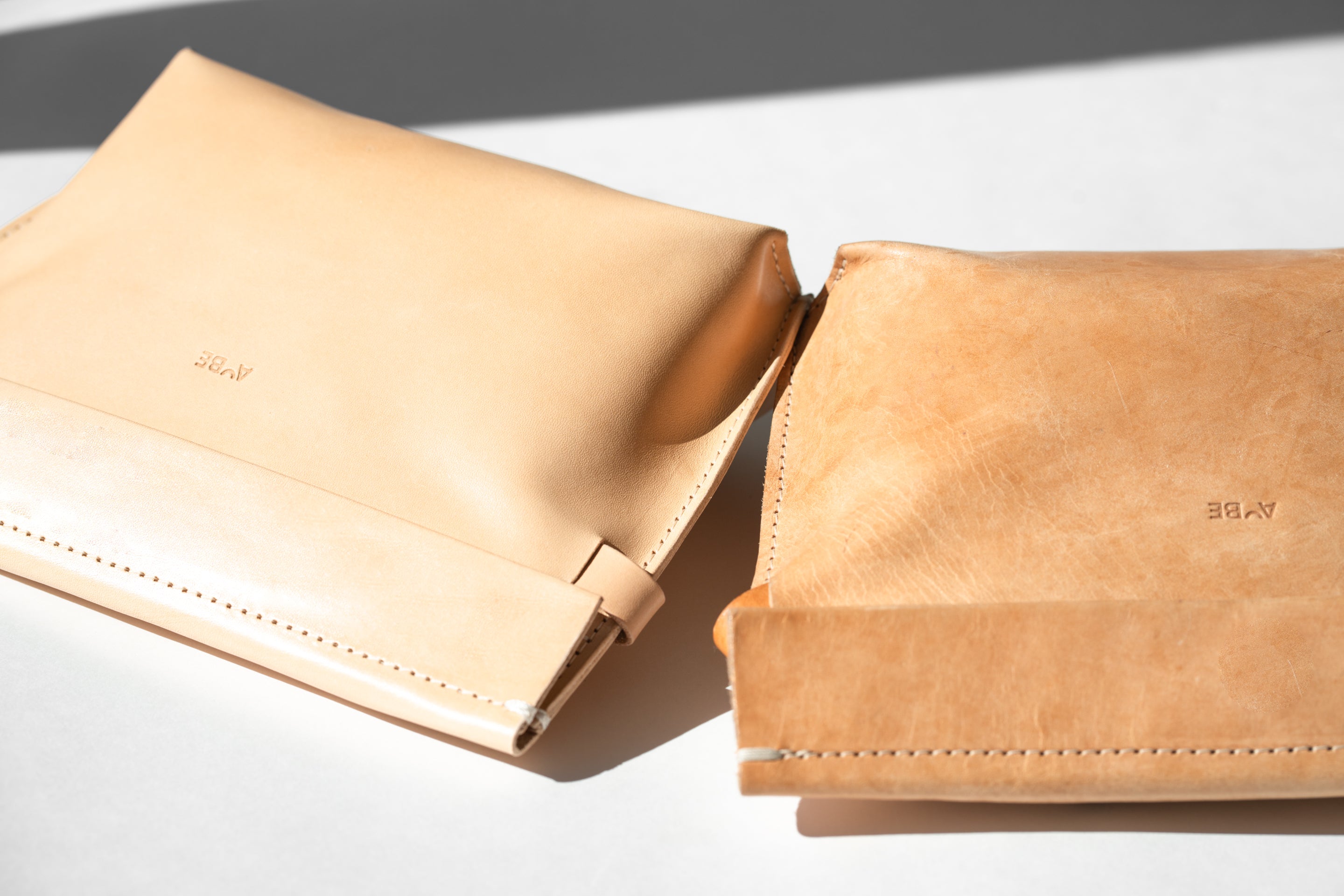Vegetable Tanned Leather
Aube Atelier uses vegetable tanned leather and here’s why:
The natural process of making vegetable tanned leather takes approximately two months and relies on tree tannins, water, and highly skilled workers. Vegetable tanned leather is a strong leather that will soften age gracefully and my favourite part is knowing that it will develop into this beautiful dark caramel patina over time. Vegetable tanned leather will outlast any other type of leather (as long as you care for it!). For all these reasons, natural tanned leather is rare, and therefore more expensive than chrome tanned leather. The latter is used for around 90% of the leather market, takes about two weeks to process and relies on chemicals that are harmful the health of the workers and the environment.
Leather is a by-product of the food industry meaning it would otherwise be thrown out if the fashion industry didn’t pick it up.
With one eye on the future
As material innovations are slowly hitting the market, I’m really hoping to be able to use plant-based leather in the future. There are experiments happening with mushrooms, pineapples, cactus leaves, and many more. However, the current reality is that these materials don’t have the strength and durability of vegetable tanned leather or they are still in development stages, hence not commercially available to smaller brand like mine.
A Note on Vegan Leather?
Vegan leather (PVC or PU) is a petroleum-based material i.e. a derivative the oil-industry and very harmful to the human health and our environment. PVC-based materials use phthalates, a set of chemicals known to cause diseases and cancer when they emanate out of the material and into the human body. The most common method used for making synthetic leather is binding a plastic (PVC or PU) to a fabric backing, so in other words, most vegan leather would be considered plastic. Synthetic leather also deteriorates rapidly and negatively impacts humans and the environment through its production, during use, and when disposed of at the end if its life. For those reasons, Aube Atelier prefers using vegetable tanned leather until sustainable synthetic leather options are available.
Water-resistant Waxed Canvas
Leather isn’t all I'm working with at Aube Atelier. Waxed canvas is also a very inspiring and durable material to work with. Waterproofing canvas with wax is a textile technique that is many centuries old. This material shares many similarities with vegetable tanned leather. Waxed canvas will age beautifully, developing an ever-changing crinkled texture. Specifically, I’ve chosen to work with a heavy cotton canvas (20oz) which I wax by hand using local beeswax from Planet Bee Honey Farm from Vernon, BC, Canada. You can go through the same process at home so your waxed canvas products maintain their water-resistant properties. Your bag will produce the most dreamy aroma.Adhesives
Quality time is spent during the design process to find ways around using adhesive. Purely using stitching methods would be preferred but when necessary, I use water-based adhesives such as Renia Aquilin.
Metal
I try to minimize the use of trims as much as possible and when needed, I opt for thee metal ones that will stand the test of time and will hold value at the end of their life. They can be easily repurposed, recycled or simply go back to nature safely.Developments are happening as we speak to lower the environmental impact of certain materials. Feel free to email me info@aubeatelier.com to share or discuss any new discoveries. I’m always thrilled to have a conversation on the topic.
Care
Leather
Laugh lines, wrinkles and scars are unique to each one of us and signs of a life well-lived and the same applies to leather leather. This material will present variations in colour, texture, and small markings and these unique imperfections should be celebrated. As a natural part of its life, leather will darken and develop this beautiful patina over time, a reflection of the way it is being used.
Regular Care
- Avoid contact with water, and extensive exposure to light as much as possible.
- Keep your leather away from heat sources
- Clean and condition as needed using a soft cloth or soft natural bristles brushes using a wax cream like Smith’s Leather Balm.
Long Term Love
- Once in a while, I would recommend consulting a leather care professionalfor a deeper, restoring treatment. This will really revive and extend the life of your product.
- Store your leather goods in a cool, dark place in a dust bag when not in use.
- A protective spray could be used for extra weather protection—make sure to spot test first.
Regardless of the care product you decide to use always do spot test first (i.e. bottom of bag, inside pocket) as conditioning/treating your leather may alter its colour or shine.
Waxed Canvas
Washing
The heavy duty waxed canvas I use is an extremely durable and requires minimal care. Waxed fabrics have been successfully used for many years without washing and you should not use detergent on your waxed canvas products.
- Start by using water first with a slight brushing or scrubbing on stained area. This is usually sufficient to remove heavy dirt.
- The next step up is to use a mild soap bar (not detergent) or Saddle soap - only if necessary and only on specific areas - to remove stubborn stains
Re-waxing
You can restore the wax finish by:
- Sparingly applying a wax refinishing ointment or melted beeswax or leaving it to absorb for a day or so (a hair dryer will speed the process).
- Follow by ironing on low heat with a thin cloth or craft paper barrier between the fabric and the iron in order to redistribute wax and relax the fabric.
NEVER use detergent, liquid or powdered. NEVER dry clean as the powerful environmentally damaging chlorinated solvents will remove the finish.
Use and enjoy your waxed cotton product. It is rugged, weather tough and made for active use.


